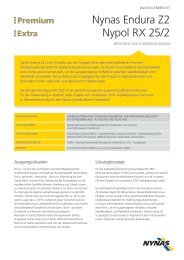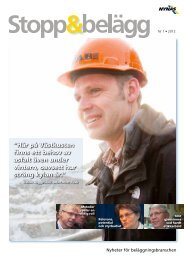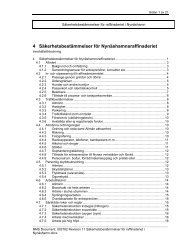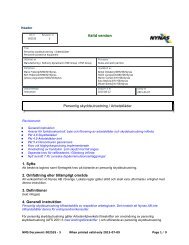A Novel Method for Determination of Paraffin Wax Content ... - Nynas
A Novel Method for Determination of Paraffin Wax Content ... - Nynas
A Novel Method for Determination of Paraffin Wax Content ... - Nynas
You also want an ePaper? Increase the reach of your titles
YUMPU automatically turns print PDFs into web optimized ePapers that Google loves.
2. MATERIALS<br />
Model compounds: A series <strong>of</strong> n-alkanes from n-hexadecane (n-C16) to n-hexatriacontane (n-C36) and an isoalkane<br />
squalane (C30H62) were selected <strong>for</strong> method validation. All the model compounds are <strong>of</strong> synthesis grade, and their<br />
melting points range from 18°C <strong>for</strong> n-C16 to 76.5°C <strong>for</strong> n-C36.<br />
Commercial waxes: A number <strong>of</strong> refined waxes were selected. The commercial waxes were branded either as<br />
microcrystalline or paraffinic by respective producers. In Table 1, in<strong>for</strong>mation provided by the producers is shown.<br />
Compared with the paraffinic waxes, the microcrystalline samples have higher melting points (MP, ASTM D 127) or<br />
congealing points (CP, ASTM D 938), indicating their molecular weight is considerably larger than the paraffinic<br />
waxes. The selected samples also included slack wax, a by-product <strong>of</strong> the de-waxing process <strong>of</strong> lubricating oil.<br />
Source Brand name Type CP or MP, °C<br />
Sasol <strong>Wax</strong><br />
Sasolwax 5805 <strong>Paraffin</strong> 58−60 (CP)<br />
Sasolwax 5604 <strong>Paraffin</strong> 55−57 (CP)<br />
Sasolwax 5891 Microcrystalline 70−75 (CP)<br />
Sasolwax 0907 Microcrystalline 83−94 (CP)<br />
Strahl & Pitsch<br />
SP 173P <strong>Paraffin</strong> 61 (MP)<br />
SP 19 Microcrystalline 81 (MP)<br />
SP 60 Microcrystalline 82 (MP)<br />
Hans-Otto Schumann<br />
GmbH& Co<br />
Terhell paraffin JA 201 Slack wax 42.5 (CP)<br />
Table 1: Characteristics <strong>of</strong> commercial waxes<br />
Crude oils and residues: Three crude oils <strong>of</strong> Venezuelan (Boscan) or Russian source and their residue were chosen<br />
(Table 2). Residue is obtained as a bottom fraction in a distillation process which separates crude oils into fractions by<br />
selective boiling points. It consists <strong>of</strong> the least volatile components at a specific boiling point (cut point). The cut points<br />
used <strong>for</strong> the three residues were 400°C <strong>for</strong> Boscan, 555°C <strong>for</strong> Russian A, and 560°C <strong>for</strong> Russian B. The yields<br />
determined by a simulated distillation using high temperature gas chromatography (HTGC) were estimated to 80% <strong>for</strong><br />
Boscan crude oil, 22% <strong>for</strong> Russian A crude oil, and 15% <strong>for</strong> Russian B crude oil. Compared with the Boscan crude oil,<br />
the Russian crude oils are more paraffnic and contain more light fractions. The crude oils and residues were further<br />
characterized using a DSC procedure described in [5], and results are shown in Table 2.<br />
DSC parameters<br />
Venezuelan (Boscan) Russian A Russian B<br />
Crude oil Residue Crude oil Residue Crude oil Residue<br />
Crystal. onset, °C 26.1 27.6 22.6 36.8 28.0 48.0<br />
Melting out temp., °C 71.3 55.0 46.5 84.5 44.0 98.3<br />
<strong>Wax</strong> content, % 4.1 0.4 12.2 2.1 9.4 4.8<br />
Table 2: DSC analysis <strong>of</strong> crude oils and corresponding residues<br />
Bitumens: Six samples <strong>of</strong> different sources and <strong>of</strong> different wax contents were selected. The bitumens are 70/100 or<br />
160/220 pen grade. Typical parameters <strong>of</strong> the bitumen samples are shown in Table 3.<br />
Bitumen Source Penetration,<br />
dmm<br />
Bit-A Venezuela 192<br />
Bit-B Venezuela 214<br />
Bit-C Middle East 205<br />
Bit-D Russia 180<br />
Bit-E Mexico 101<br />
Bit-F Unknown 86<br />
Table 3: Bitumen samples<br />
S<strong>of</strong>tening<br />
point, °C<br />
37.8<br />
39.1<br />
39.2<br />
40.1<br />
45.1<br />
46.4<br />
2<br />
Vis. 135°C, <strong>Wax</strong> content, %<br />
mm 2 /s EN 12606-1 DSC<br />
199<br />
0.4<br />
0<br />
283<br />
1.1<br />
2.4<br />
225<br />
1.3<br />
4.2<br />
202<br />
1.5<br />
4.1<br />
325<br />
1.2<br />
4.1<br />
181<br />
1.7<br />
6.2








![Säkerhetsbestämmelser Gbg rev 5.ppt [Compatibility Mode] - Nynas](https://img.yumpu.com/18742268/1/190x146/sakerhetsbestammelser-gbg-rev-5ppt-compatibility-mode-nynas.jpg?quality=85)







